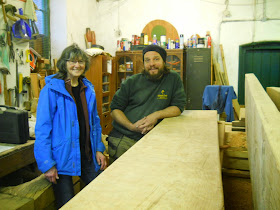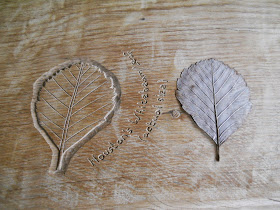Libby Houston is one of the subjects carved into the large oak bench that I've been working on. She has had six books of poetry published as well as being a winner of the prestigious H.H. Bloomer award, which is given by the Linnean society to 'an amateur naturalist who has made an important contribution to biological knowledge'.
It was a bit nerve-wracking for me, as this was the first time that I've actually shown someone a carved portrait that I've done of them. Libby seemed to like it though...Phew!
I've also carved two lines from her poem 'The Trees Dance' onto the tops of the backrests.
Libby looked over the text to be carved about her on a previous visit, which meant that I don't need to worry about any inaccuracies too much! It was great chatting with her about the rare and unusual trees and plants that can be found in the area. One that was mentioned is Spiked Speedwell, which is rare and lives on the rock faces in the Avon Gorge.
 |
| Image from:http://www.ukwildflowers.com/ |
This plant colonised the area just after the land was stripped bare by the glaciers of the last Ice Age. It is at home on steep rock faces and very thin soils, so survived in the Gorge when other plants and trees took over elsewhere in the area. It is also perennial, so it grows back from the same rootstock every year.
Libby said that there is debate amongst botanists as to how long these plants can live for and some believe that in favourable conditions, such as in the Gorge, individual plants could be thousands of years old, possibly even 10,000 years. This is impossible to test at the moment as far as I know but if it is true, it would mean that the plant seen now is exactly the same one that started growing next to the retreating ice sheet!
We also chatted about Hutchinsia, a tiny perennial flower that lives its life cycle through the winter to avoid competition from other plants. It starts growing in autumn and flowers in March. By springtime, when everything else begins their season, it is done for the year and dies back.
 |
| Image by natterjacktoad from http://www.ispotnature.org/species-dictionaries/uksi/Hornungia%20petraea |
Whitebeams are also a bit unusual in the natural world, as they will hybridise with certain other species (such as the Wild Service Tree Sorbus torminalis) and produce fertile offspring. Usually when species interbreed, the offspring are sterile. An example of this would be mules, the result of a horse breeding with a donkey. Nearly all mules cannot produce offspring themselves.
Whitebeams are also often found on steep slopes and thin soils, where they can live without being overshadowed and having to compete for resources with larger trees such as ash, beech or oak. This local high density of population, together with their fertile hybrid offspring, means that they often interbreed and produce new species. There are at least three unique species in the Avon Gorge alone.
One of the Whitebeam species has possibly my favourite name of any tree. It grows near Watersmeet, on Exmoor in the Southwest of England, and is called the 'No Parking Whitebeam' (Sorbus admonitor). Why the strange name? The first example was found next to a road and had a 'No Parking' sign fixed to it.
Libby also kindly gave me two fallen leaves from a Whitebeam tree that she discovered in the Avon Gorge to copy in a woodcarving on the bench. It is named 'Houston's Whitebeam' after her. There is only one specimen of this kind of tree known to exist, so I suppose it must be one of the rarest trees in the world.
By the way, the piece of dowel next to the leaf on the right is plugging a hole left when I dug some lead shot out of the wood. I wonder how long it had been in there?

















